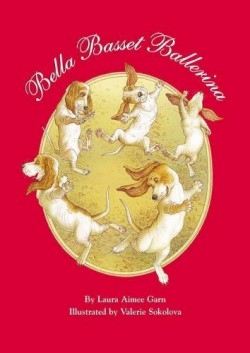
Bella Basset Ballerina
Endorsements from canine friends and relations of the author adorn the back cover of this charming tale in which a young pooch, who lives in Bowserburg (a suburb of tony Fideaux Falls), disregards doggy destiny to achieve her dream of becoming a ballerina.
Bella Basset’s mother takes her to see the Royal Borzoi Ballet Company at the Fideaux Falls Opera House for her birthday. She is enchanted by the long-legged grace of Borzoi prima ballerina Mademoiselle Ada and decides to become a dancer too. Undaunted by her mother’s assertion that short-legged Bassets are only “suited to country life,” Bella practices leaping and jumping until she can land “with a spring in her step.” However, when she waits by the stage door for Mademoiselle Ada, the aloof Borzoi states scathingly that Bassets are not meant to dance.
The sympathetic wardrobe mistress, Wolfhound Madame Petrovna, sends her to a renowned dance instructor, who is so impressed by Bella’s bounds that he overcomes his breed prejudice to teach her privately. In time, he sends her to the sophisticated Big City where species mingle freely and anyone can become a star. When her dazzling leaps land her a feature role in the Sirloin Sonata, she becomes an overnight sensation. Universally acclaimed, Bella graciously remains silent when the snooty Mademoiselle Ada claims credit for Bella’s success. Instead, she fights elitism by teaching a master class for “Aspiring Dancers of Unusual Breeds.”
The author holds Masters of Fine Arts degrees in graphic design from Yale and Columbia, and is also the founder of the Pretty Please Press. This is Garn’s first book, and the company’s debut publication; coming soon is The Scritchy Little Twitchell Sisters.
Young readers will understand the story’s message—it’s best to ignore one’s detractors and simply move to one’s own beat (or paw)—although they may also think that Mademoiselle Ada should suffer for her prejudiced, self-serving behavior. In fact, the text doesn’t deal directly with how hurtful a class- (or breed-) based system can be. Bella’s magnanimity lets readers down a little, as does the author’s use of masculine pronouns. Phrases like “each dog to his own path” and “every dog has his day” may be jarring to readers, especially in a story populated mostly by female characters, but they underscore the irrelevance of absolutist decrees.
The illustrator has also provided art for The Magic of Merlin and Thankful Together. Her picturesque illustrations here will delight: Bella and her family are endearingly wrinkled; dancers’ costumes are deliciously canine; and both Bowserburg and Big City glitter with visual tidbits such as signs for “Buffalopolis” and “Café Canem.” Her delightful drawings of Bella flying through the air in a variety of poses will endear the book to young readers at first glance.
Reviewed by
Elizabeth Breau
Disclosure: This article is not an endorsement, but a review. The publisher of this book provided free copies of the book to have their book reviewed by a professional reviewer. No fee was paid by the publisher for this review. Foreword Reviews only recommends books that we love. Foreword Magazine, Inc. is disclosing this in accordance with the Federal Trade Commission’s 16 CFR, Part 255.
